Chto Delat
21.06.2021 – 22.10.2021
Exhibition Views
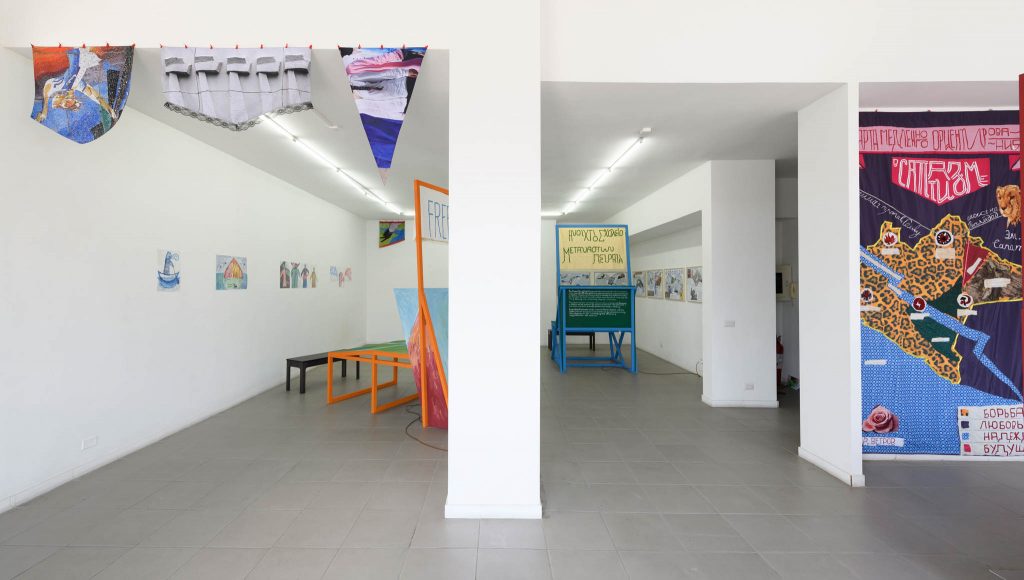
New kinetic melodies: on miracles, disasters and mutations for the future, 2021, installation view at The Gallery Apart, Rome (ground floor), photo by Giorgio Benni
New kinetic melodies: on miracles, disasters and mutations for the future, 2021, installation view at The Gallery Apart, Rome (ground floor), photo by Giorgio Benni 
New kinetic melodies: on miracles, disasters and mutations for the future, 2021, installation view at The Gallery Apart, Rome (ground floor), photo by Giorgio Benni 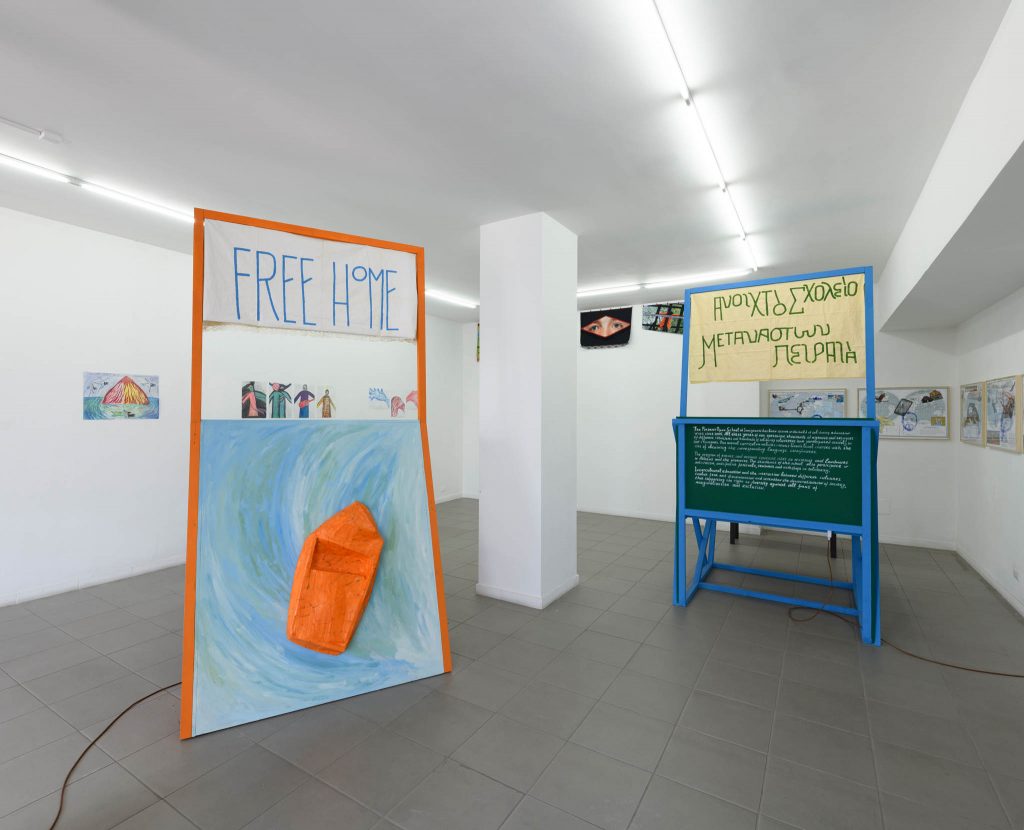
Chto Delat. New kinetic melodies: on miracles, disasters and mutations for the future, 2021, installation view at The Gallery Apart, Rome (ground floor), Photo by Giorgio Benni 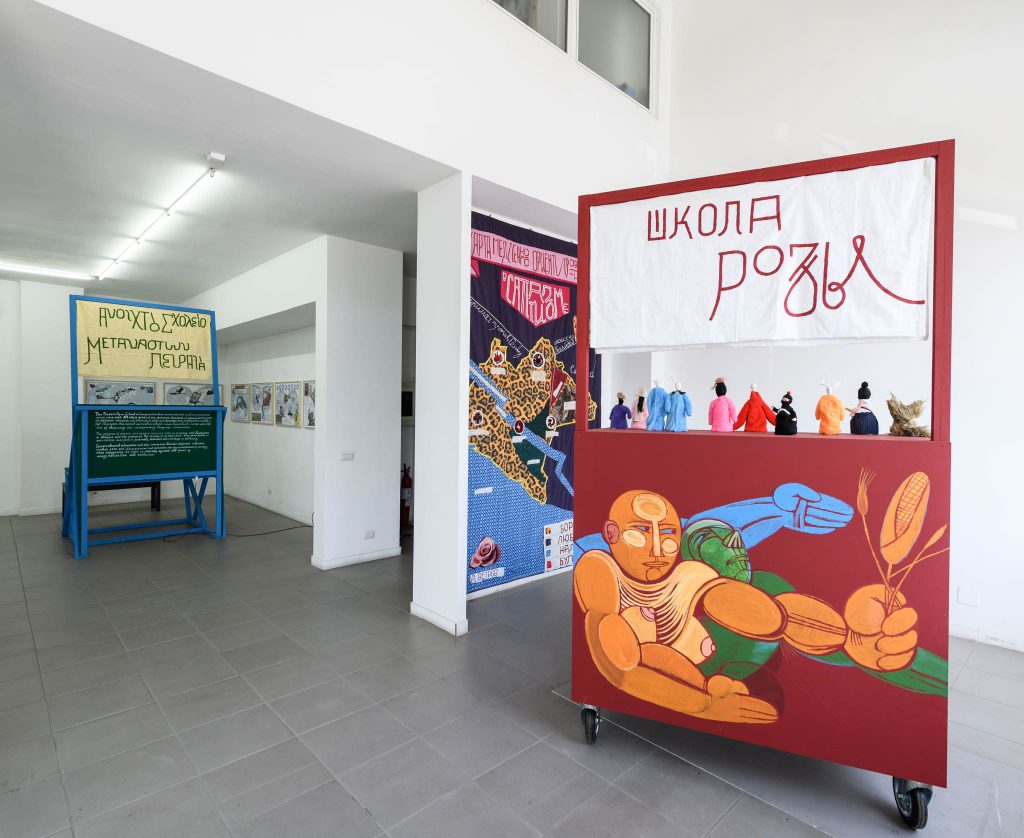
New kinetic melodies: on miracles, disasters and mutations for the future, 2021, installation view at The Gallery Apart, Rome (ground floor), photo by Giorgio Benni 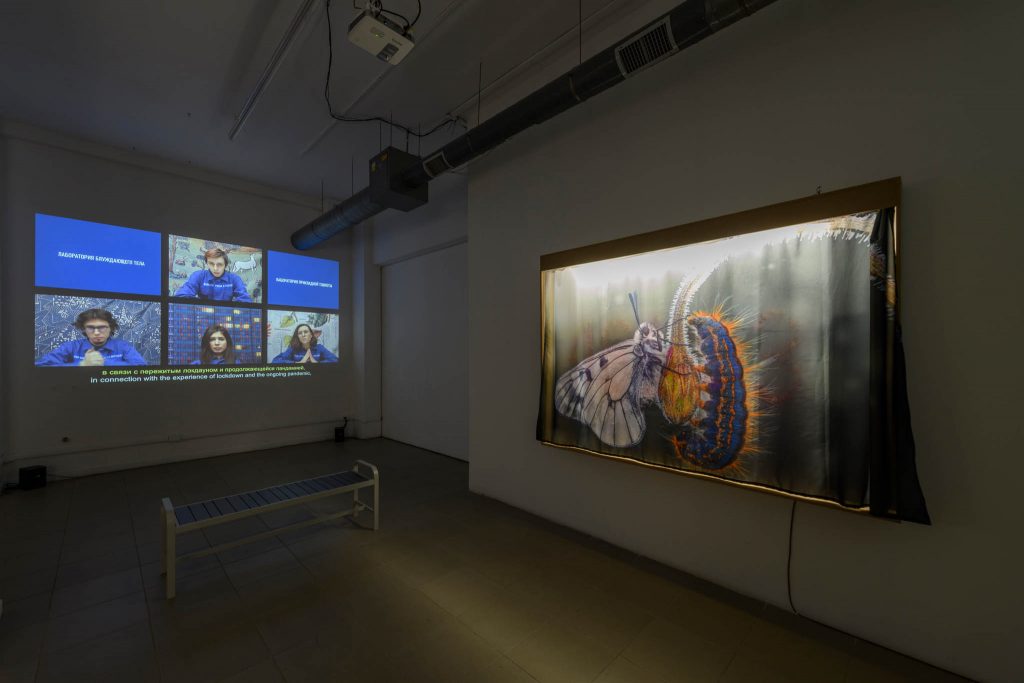
New kinetic melodies: on miracles, disasters and mutations for the future, 2021, installation view at The Gallery Apart, Rome (basement), photo by Giorgio Benni 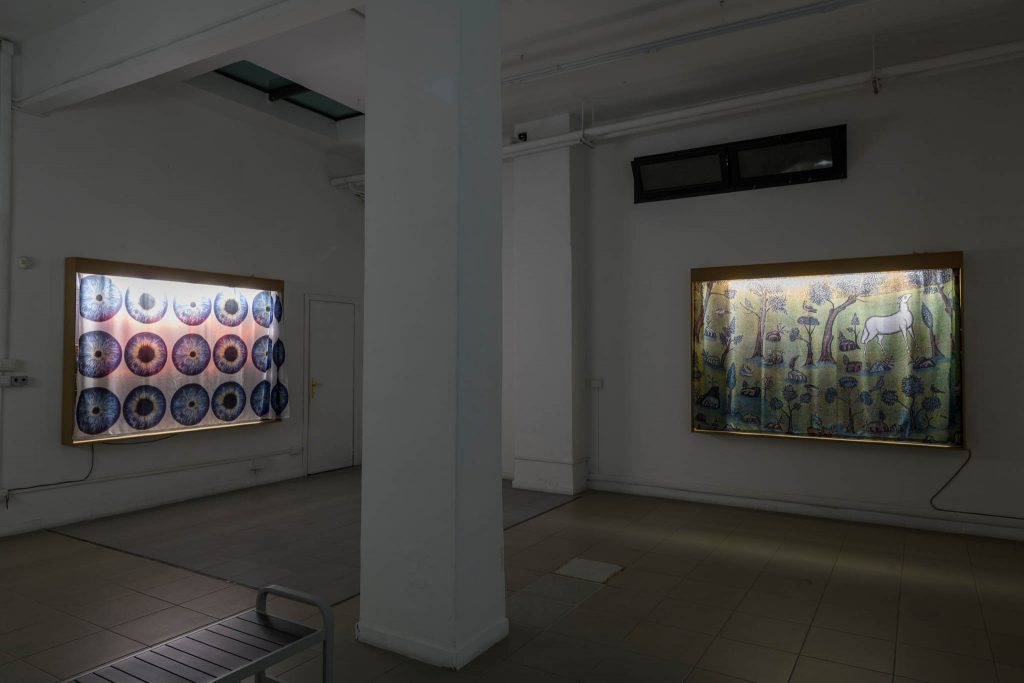
New kinetic melodies: on miracles, disasters and mutations for the future, 2021, installation view at The Gallery Apart, Rome (basement), photo by Giorgio Benni 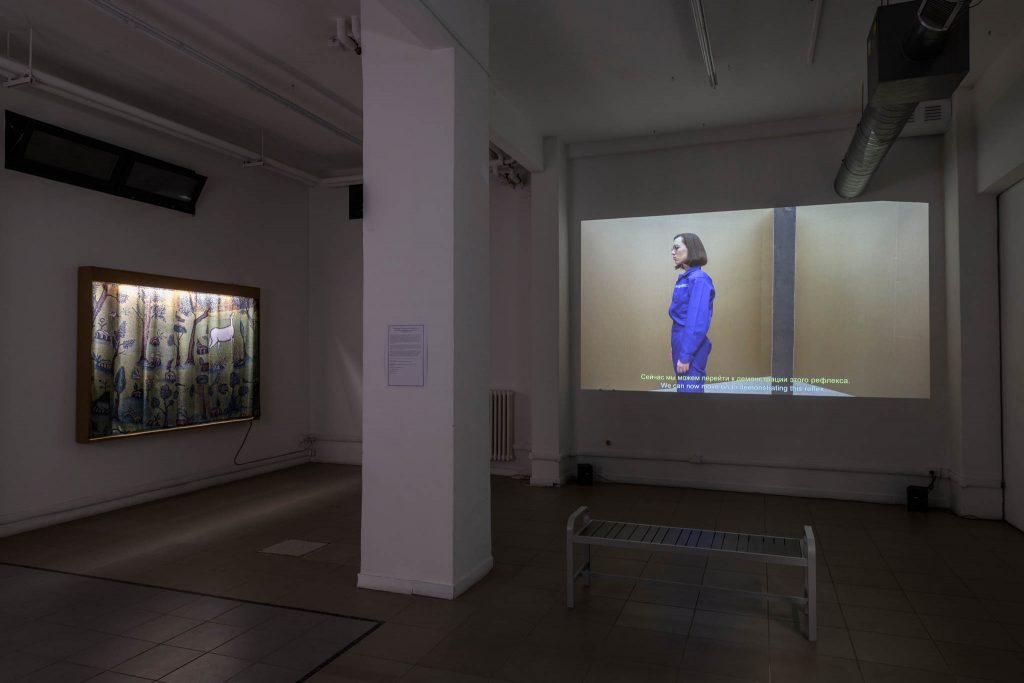
New kinetic melodies: on miracles, disasters and mutations for the future, 2021, installation view at The Gallery Apart, Rome (basement), photo by Giorgio Benni
Works
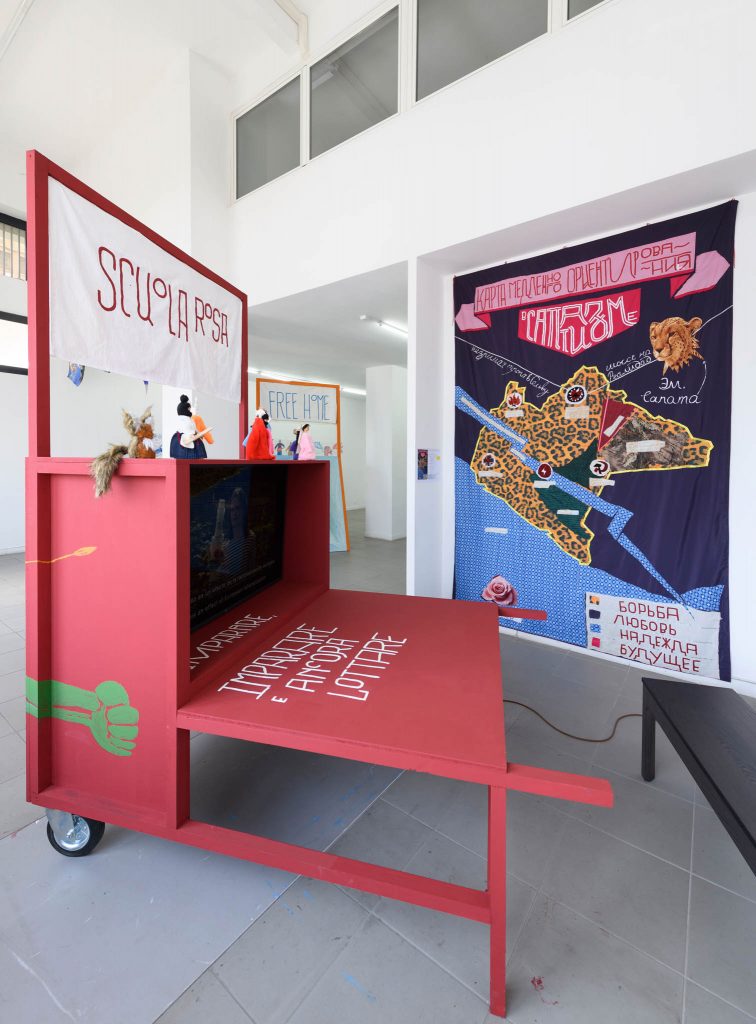
Learning Station #1, ‘The School of Roza’, 2021, wooden assemblage, textile, acrylic (realized by Nikolay Oleynikov) and video The New Deadline #17. Summer School of Slow Orientation in Zapatism, 2017, 90 min., loop (directed by Tsaplya Olga Egorova), photo by Giorgio Benni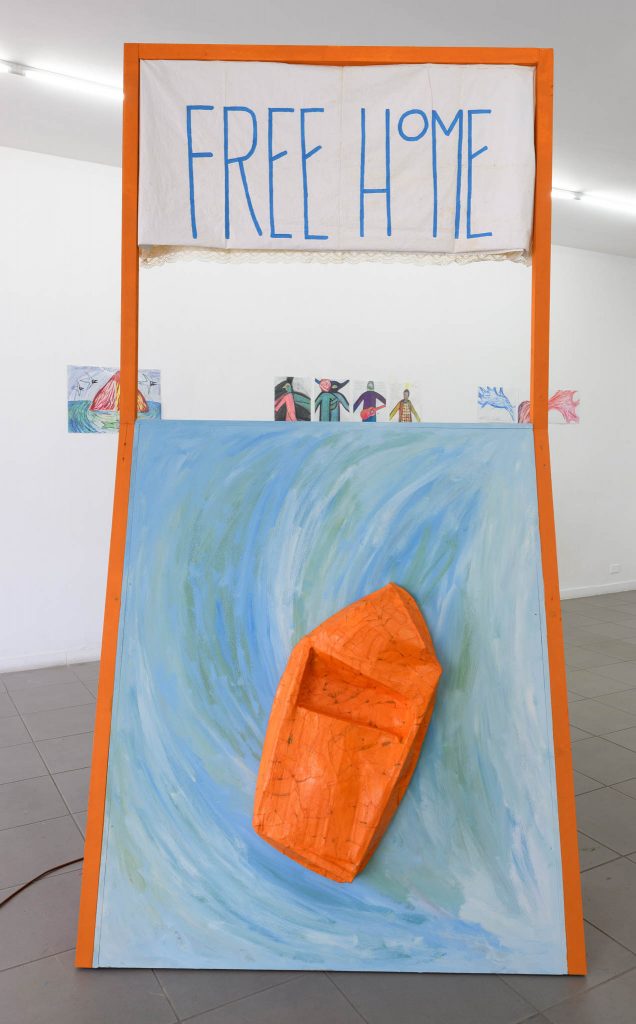
Learning Station #2, “Free Home University”, 2021, wooden assemblage, textile, acrylic (realized by Nikolay Oleynikov) and video People of Flour, Salt, and Water, 2019, 73 min., loop (directed by Tsaplya Olga Egorova), photo by Giorgio Benni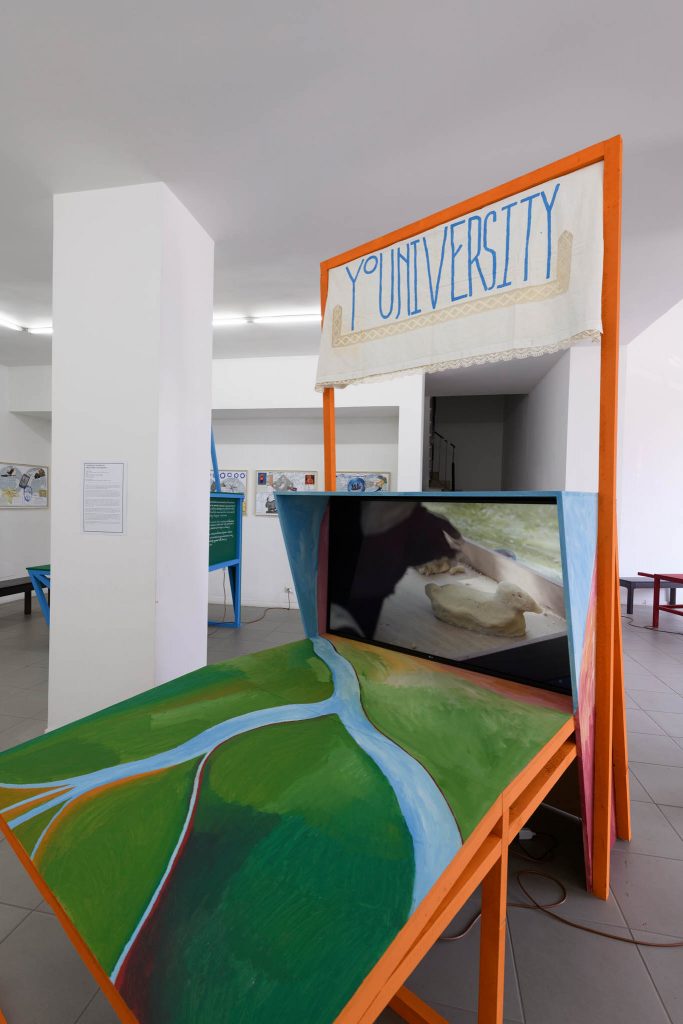
Learning Station #2, “Free Home University”, 2021, wooden assemblage, textile, acrylic (realized by Nikolay Oleynikov) and video People of Flour, Salt, and Water, 2019, 73 min., loop (directed by Tsaplya Olga Egorova), photo by Giorgio Benni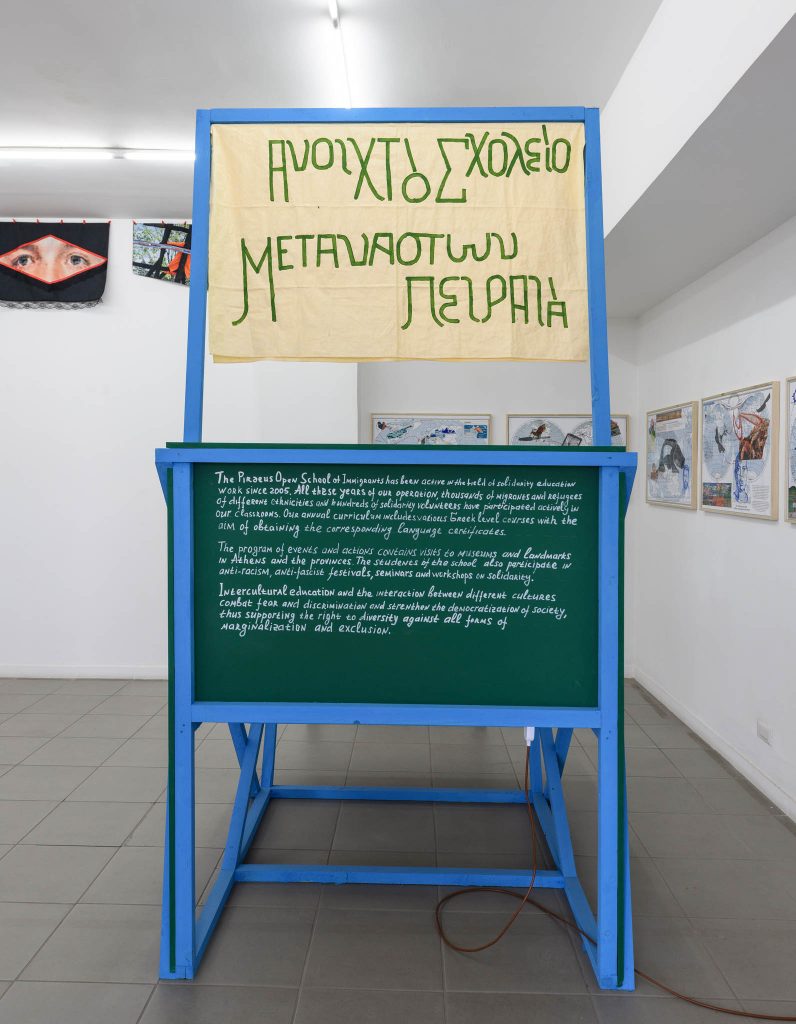
Learning Station #3, “The Piraeus Open School for Migrants”, 2021, wooden assemblage, textile, acrylic (realized by Nikolay Oleynikov) and video About the Footprints, what we hide in Our Pockets and other shadows of hope, 2021, 84 min., loop (directed by Dmitry Vilensky), photo by Giorgio Benni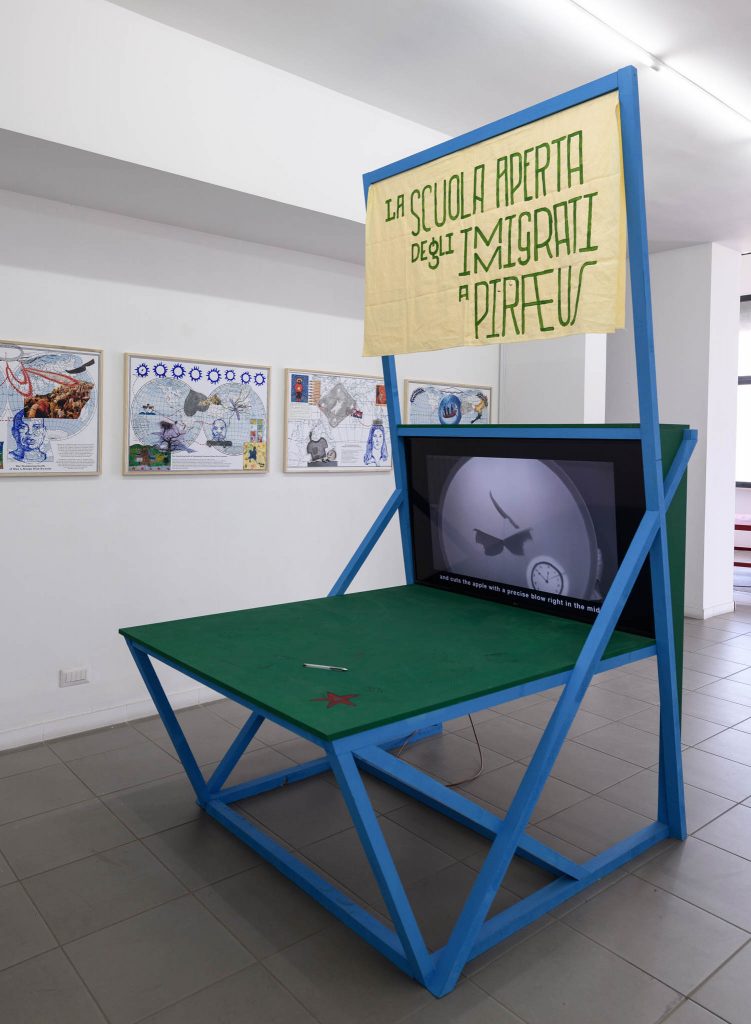
Learning Station #3, “The Piraeus Open School for Migrants”, 2021, wooden assemblage, textile, acrylic (realized by Nikolay Oleynikov) and video About the Footprints, what we hide in Our Pockets and other shadows of hope, 2021, 84 min., loop (directed by Dmitry Vilensky), photo by Giorgio Benni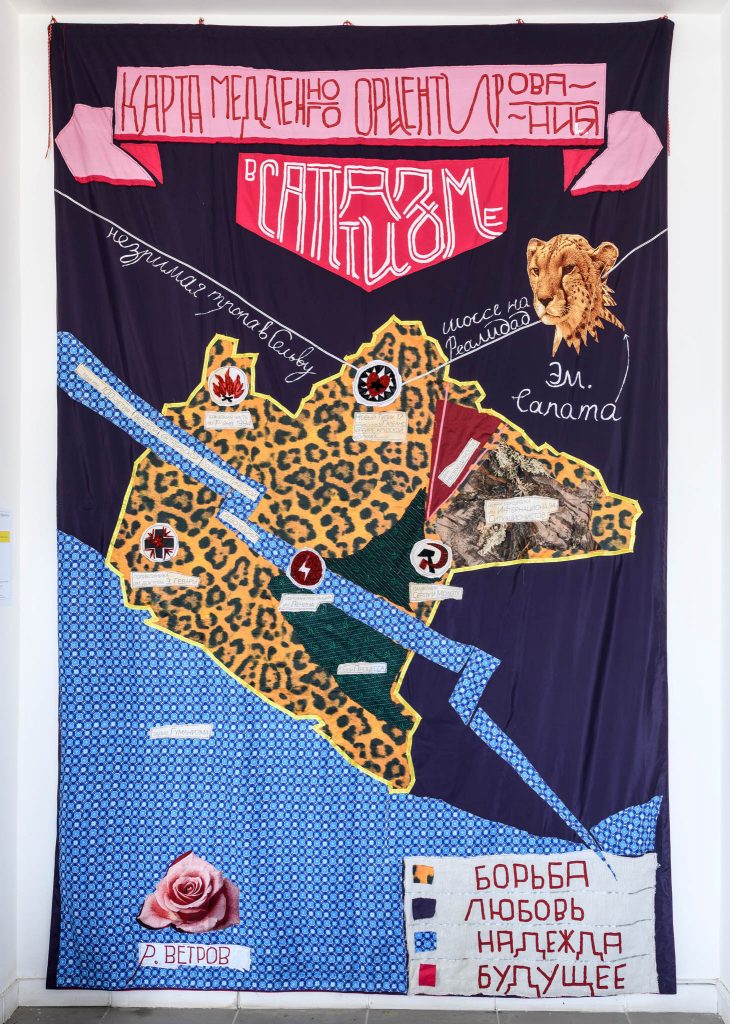
Map of Slow Orientation in Zapatismo – Paris version, 2017, mixed textiles (sewed), vinyl paint, cm 300 x 200, (realized by Nikolay Oleynikov with SHVEMY seweing cooperative), photo by Giorgio Benni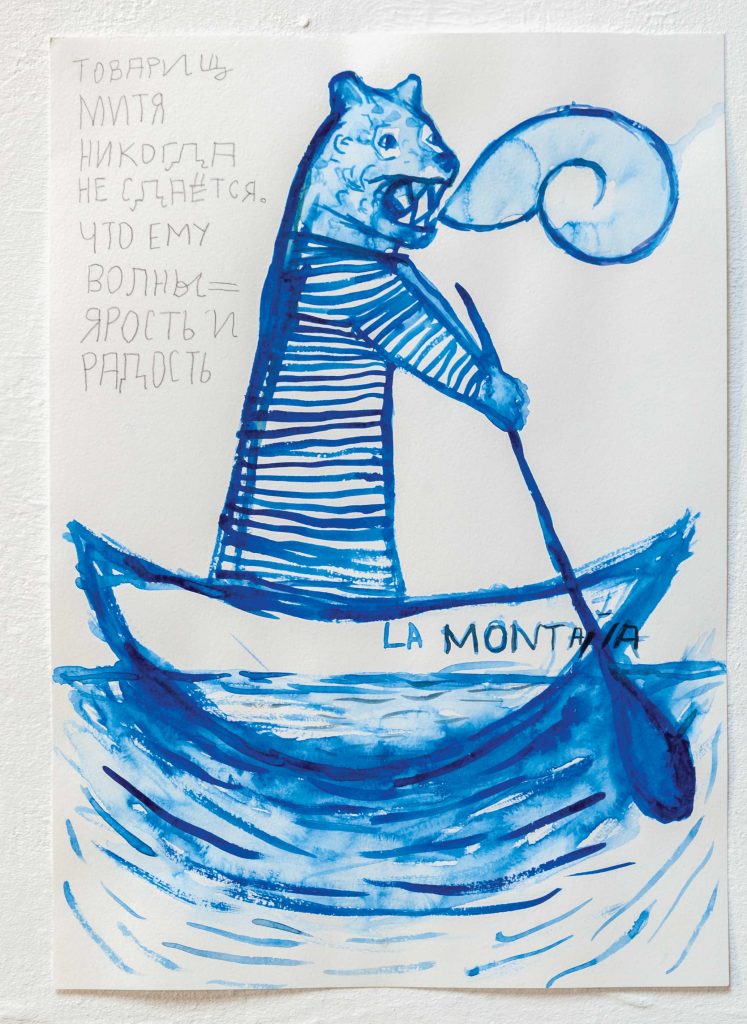
Untitled (Mitya el Remero…), from series And the Embassy Sails On, 2021, drawings series, mixed media, 29,7 x 42 cm, (realized by Nikolay Oleynikov), photo by Michael Oleynikov 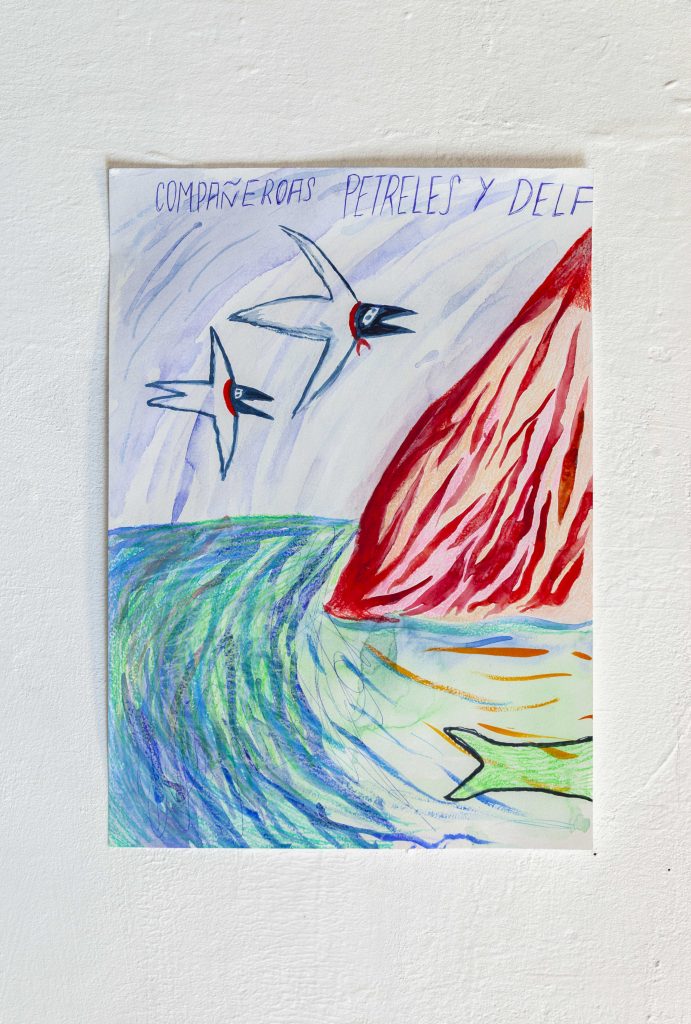
Untitled (La Montaña…), from series And the Embassy Sails On, 2021, drawings series, mixed media, 42 x 60 cm (diptych), (realized by Nikolay Oleynikov), photo by Michael Oleynikov 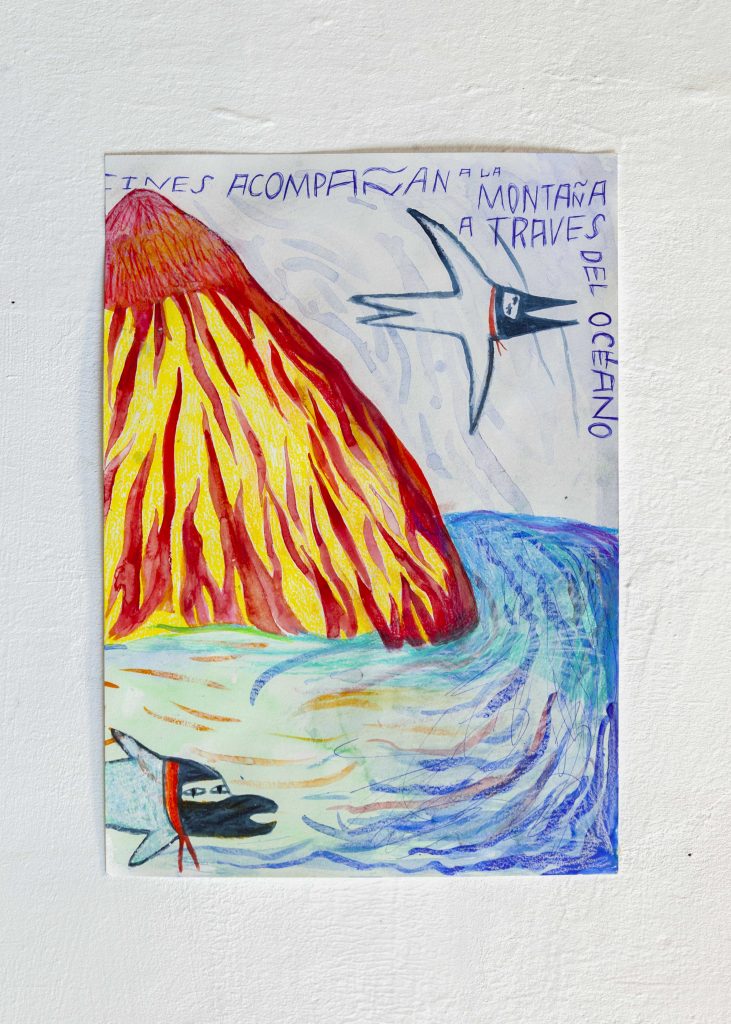
Untitled (La Montaña…), from series And the Embassy Sails On, 2021, drawings series, mixed media, 42 x 60 cm (diptych), (realized by Nikolay Oleynikov), photo by Michael Oleynikov 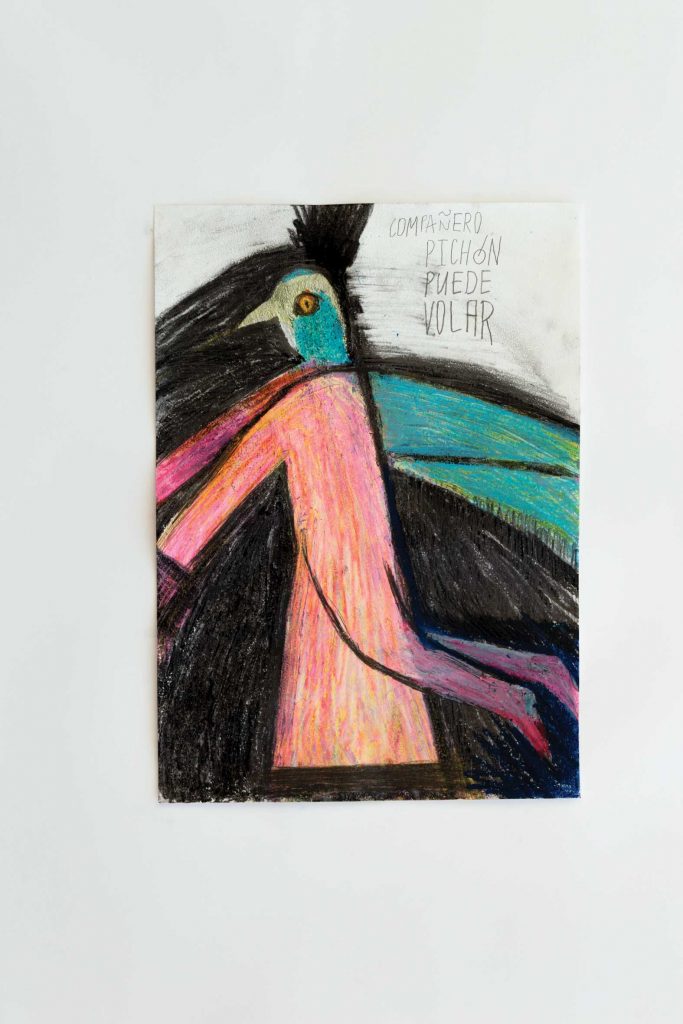
Cumbia-Jorovod (Compañero Pinchon…; Compas; Compa Violazul…; Maestra Maiz), from series And the Embassy Sails On, 2021, drawings series, mixed media, 42 x 29,7 cm (each), (realized by Nikolay Oleynikov), photo by Michael Oleynikov 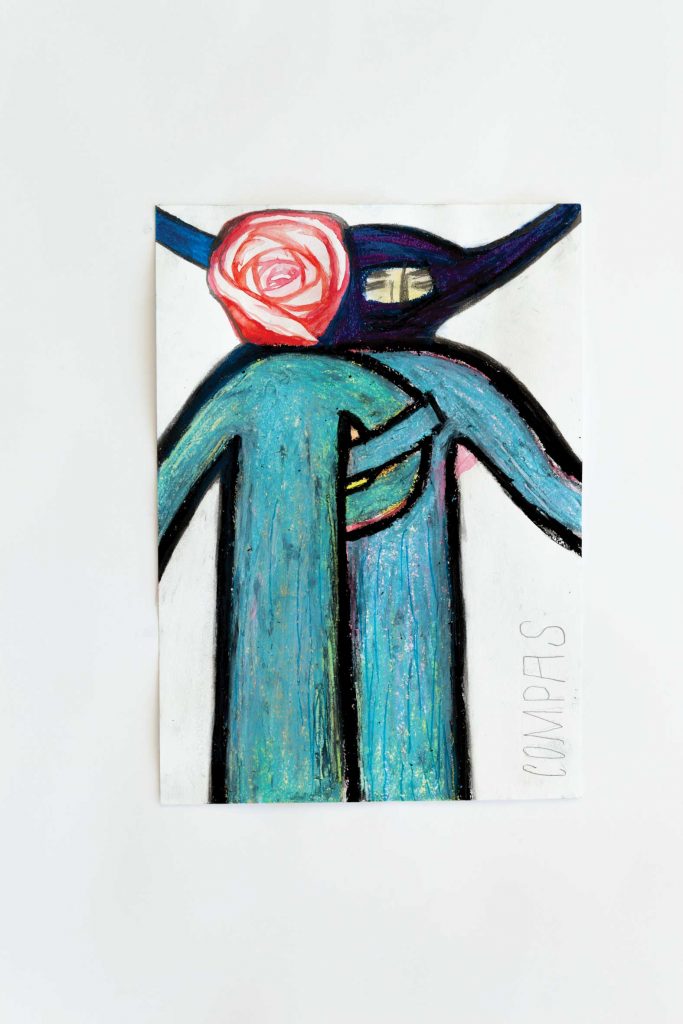
Cumbia-Jorovod (Compañero Pinchon…; Compas; Compa Violazul…; Maestra Maiz), from series And the Embassy Sails On, 2021, drawings series, mixed media, 42 x 29,7 cm (each), (realized by Nikolay Oleynikov), photo by Michael Oleynikov 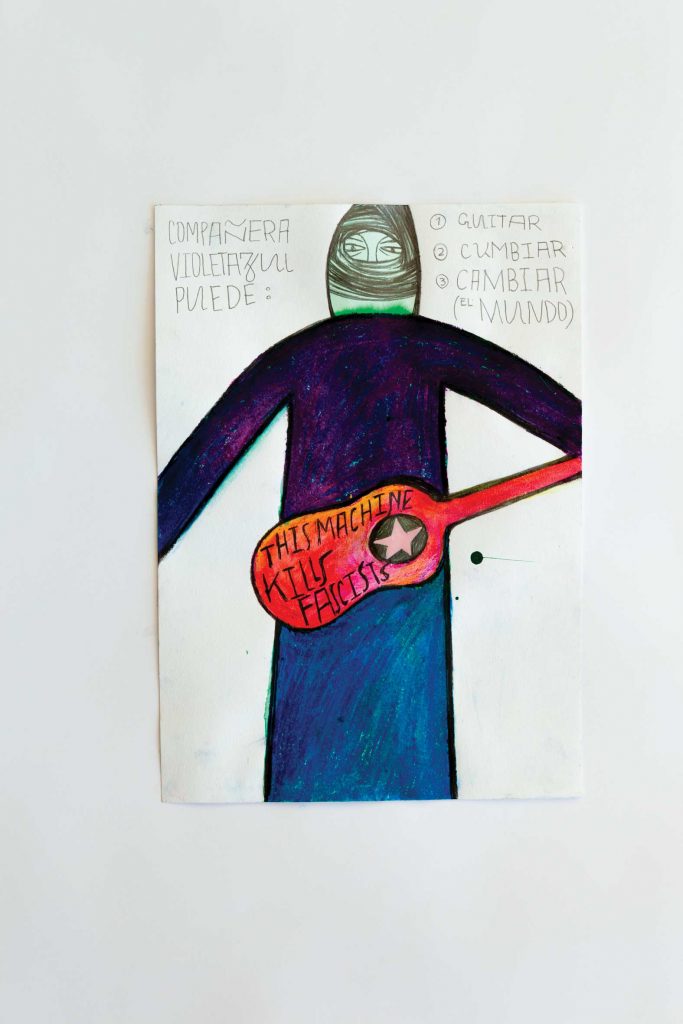
Cumbia-Jorovod (Compañero Pinchon…; Compas; Compa Violazul…; Maestra Maiz), from series And the Embassy Sails On, 2021, drawings series, mixed media, 42 x 29,7 cm (each), (realized by Nikolay Oleynikov), photo by Michael Oleynikov 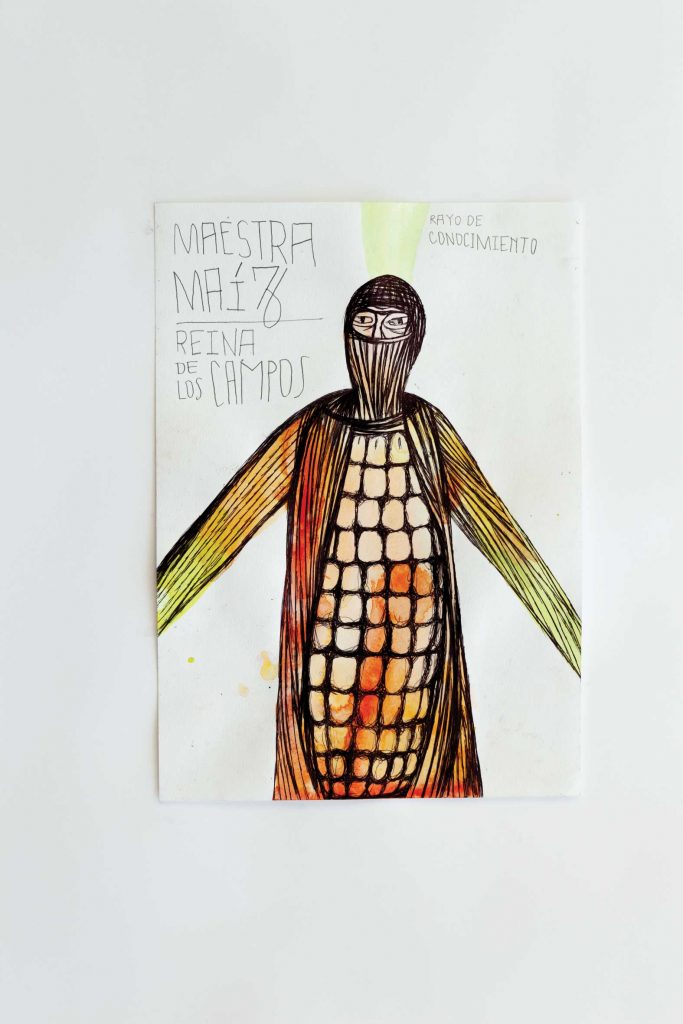
Cumbia-Jorovod (Compañero Pinchon…; Compas; Compa Violazul…; Maestra Maiz), from series And the Embassy Sails On, 2021, drawings series, mixed media, 42 x 29,7 cm (each), (realized by Nikolay Oleynikov), photo by Michael Oleynikov 
Untitled (Compañero Los…), from series And the Embassy Sails On, 2021, drawings series, mixed media, 42 x 29,7 cm each (triptych), (realized by Nikolay Oleynikov), photo by Michael Oleynikov 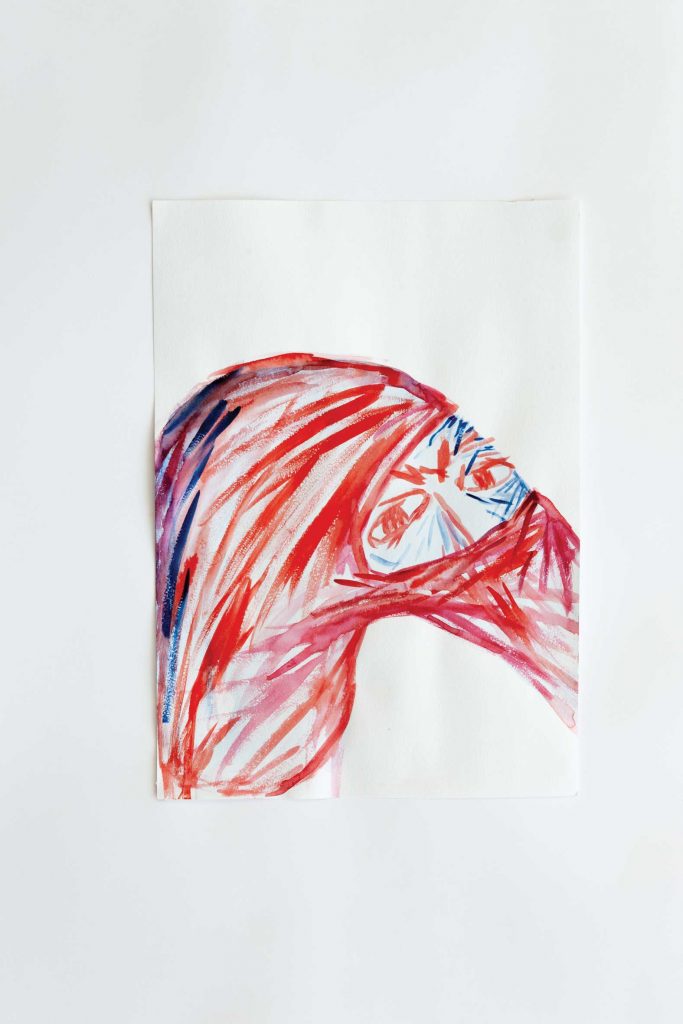
Untitled (Compañero Los…), series And the Embassy Sails On, 2021, drawings series, mixed media, 42 x 29,7 cm each (triptych), (realized by Nikolay Oleynikov), photo by Michael Oleynikov 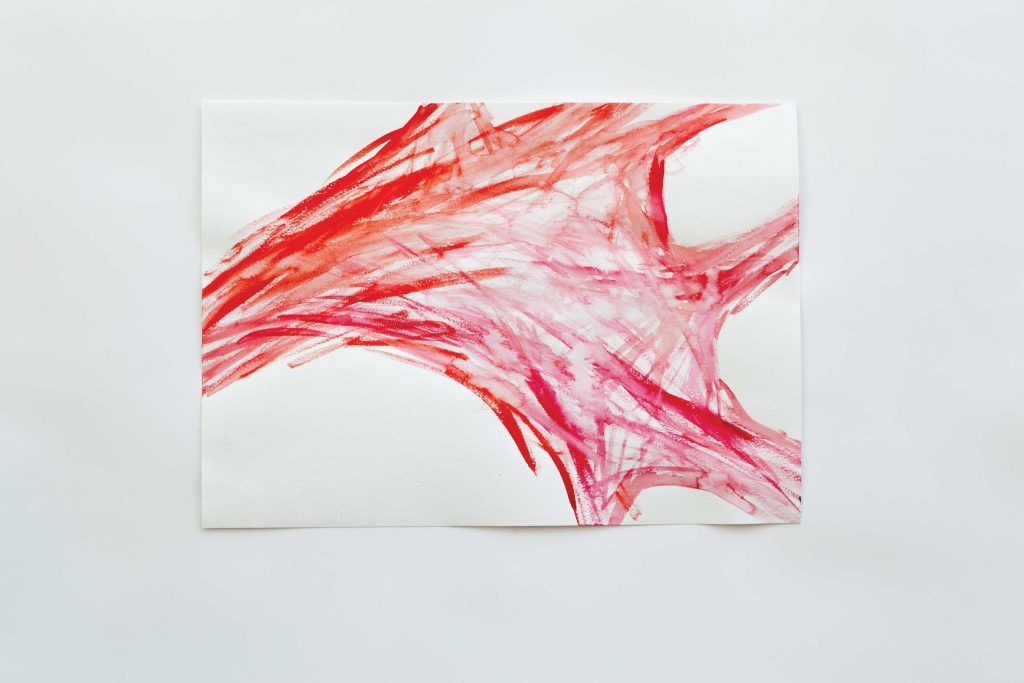
Untitled (Compañero Los…), from series And the Embassy Sails On, 2021, drawings series, mixed media, 42 x 29,7 cm each (triptych), (realized by Nikolay Oleynikov), photo by Michael Oleynikov 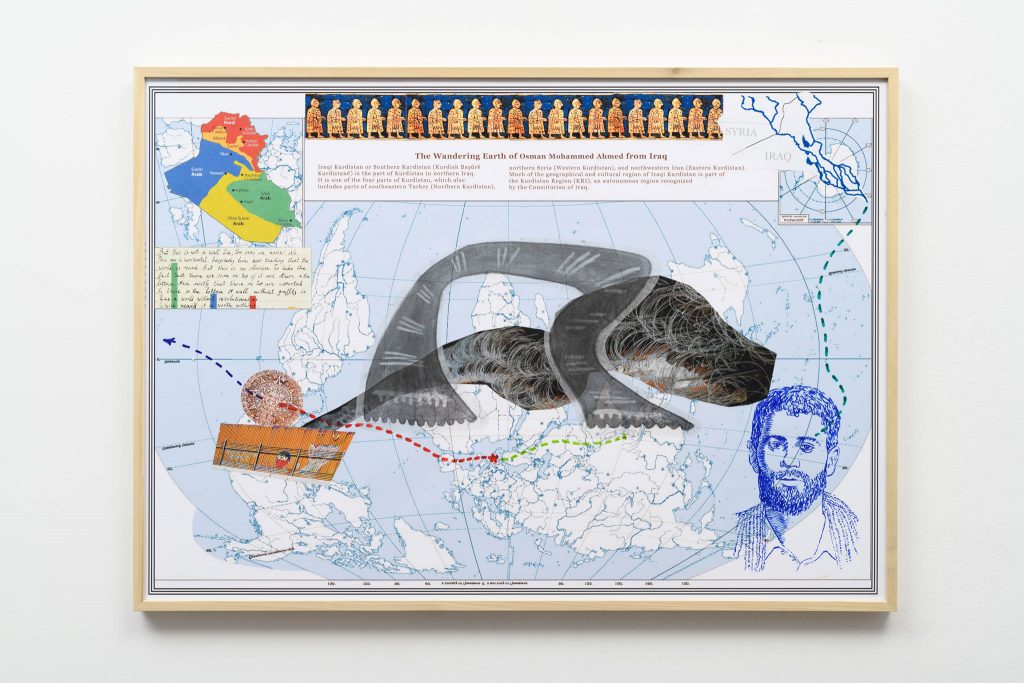
Wandering Earth, Version 1, 2021, collages series, pencil, ink, permanent markers, vellum, found images over digitally processed and printed maps, cm 60 x 83 (not framed), (realized by Dmitry Vilensky, graphic assistant Evgeny Antonov), photo by Giorgio Benni
Wandering Earth, Version 1, 2021, collages series, pencil, ink, permanent markers, vellum, found images over digitally processed and printed maps, cm 60 x 83 (not framed), (realized by Dmitry Vilensky, graphic assistant Evgeny Antonov), photo by Giorgio Benni 
Wandering Earth, Version 1, 2021, collages series, pencil, ink, permanent markers, vellum, found images over digitally processed and printed maps, cm 60 x 83 (not framed), (realized by Dmitry Vilensky, graphic assistant Evgeny Antonov), photo by Giorgio Benni 
Wandering Earth, Version 1, 2021, collages series, pencil, ink, permanent markers, vellum, found images over digitally processed and printed maps, cm 60 x 83 (not framed), (realized by Dmitry Vilensky, graphic assistant Evgeny Antonov), photo by Giorgio Benni 
Wandering Earth, Version 1, 2021, collages series, pencil, ink, permanent markers, vellum, found images over digitally processed and printed maps, cm 60 x 83 (not framed), (realized by Dmitry Vilensky, graphic assistant Evgeny Antonov), photo by Giorgio Benni 
Wandering Earth, Version 1, 2021, collages serie, pencil, ink, permanent markers, vellum, found images over digitally processed and printed maps, cm 60 x 83 (not framed), (realized by Dmitry Vilensky, graphic assistant Evgeny Antonov), photo by Giorgio Benni 
Wandering Earth, Version 1, 2021, collages series, pencil, ink, permanent markers, vellum, found images over digitally processed and printed maps, cm 60 x 83 (not framed), (realized by Dmitry Vilensky, graphic assistant Evgeny Antonov), photo by Giorgio Benni 
Behind our virtual background. Object #1, 2021, wooden installation, textiles, photos and artificial flowers, cm 160 x 220 x 15, (realized by Dmitry Vilensky), photo by Giorgio Benni 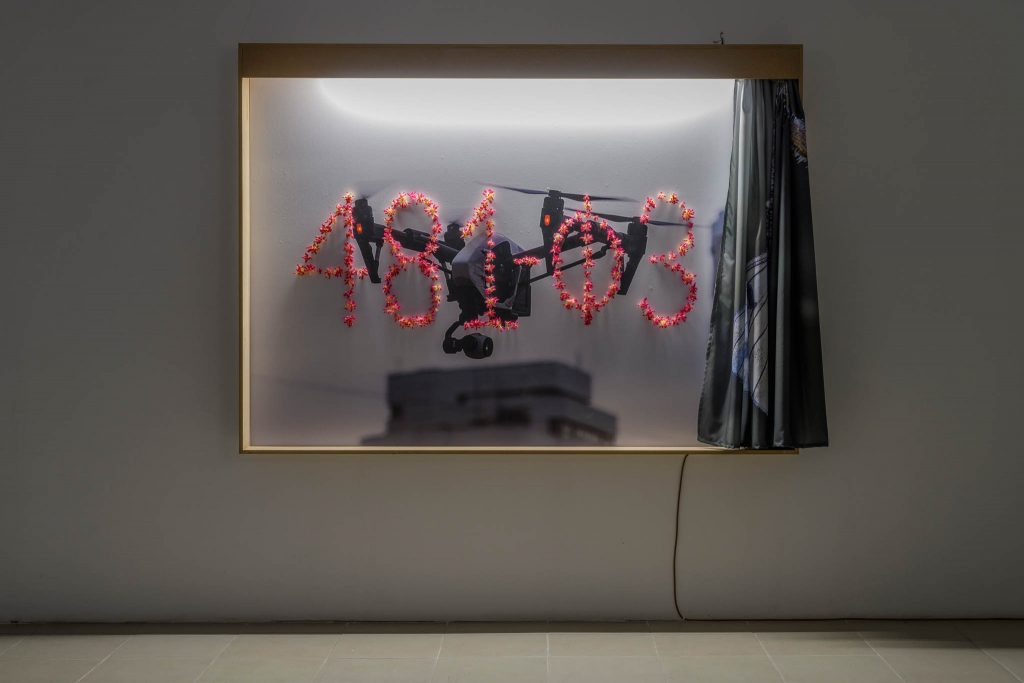
Behind our virtual background. Object #1, 2021, wooden installation, textiles, photos and artificial flowers, cm 160 x 220 x 15, (realized by Dmitry Vilensky), photo by Giorgio Benni 
Behind our virtual background. Object #2, 2021, wooden installation, textiles, photos and artificial flowers, cm 160 x 220 x 15, (realized by Dmitry Vilensky), photo by Giorgio Benni 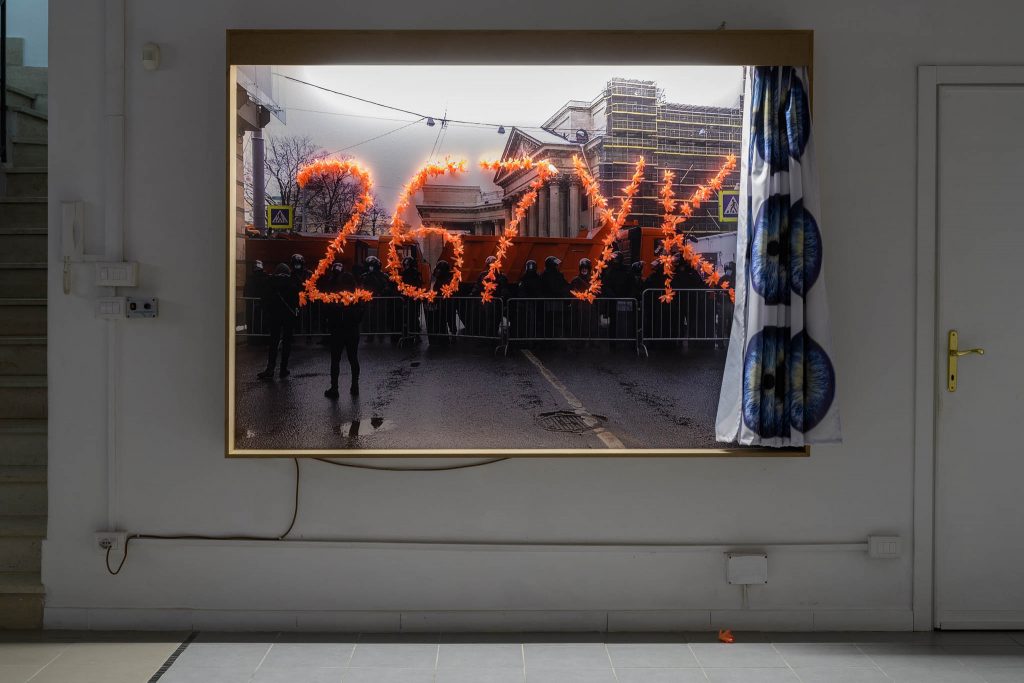
Behind our virtual background. Object #2, 2021, wooden installation, textiles, photos and artificial flowers, cm 160 x 220 x 15, (realized by Dmitry Vilensky), photo by Giorgio Benni 
Behind our virtual background. Object #3, 2021, wooden installation, textiles, photos and artificial flowers, cm 160 x 220 x 15, (realized by Dmitry Vilensky), photo by Giorgio Benni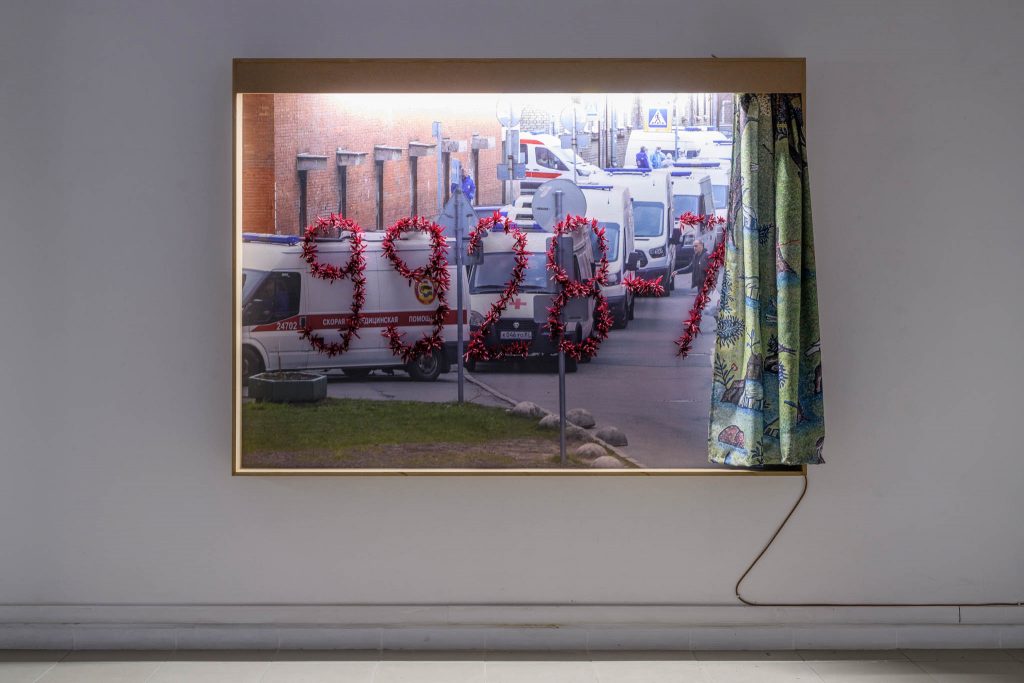
Behind our virtual background. Object #3, 2021, wooden installation, textiles, photos and artificial flowers, cm 160 x 220 x 15, (realized by Dmitry Vilensky), photo by Giorgio Benni 
Untitled (Bakic), series Navigation Signal Flag System. Set #3, Some Signals Registered From Chiapas, 2021, 13 double-sided pieces, poster, textile, digital print, sewing, variable dimensions, photo by Giorgio Benni
Untitled (La Niña), series Navigation Signal Flag System. Set #3, Some Signals Registered From Chiapas, 2021, 13 double-sided pieces, poster, textile, digital print, sewing, variable dimensions, photo by Giorgio Benni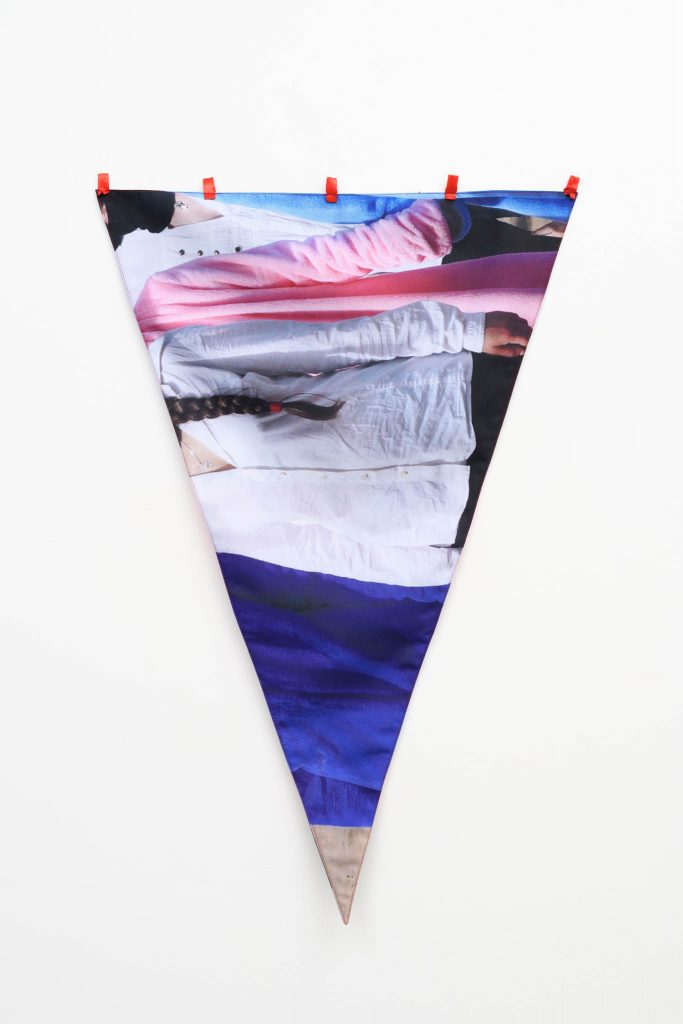
Untitled (On March), series Navigation Signal Flag System. Set #3, Some Signals Registered From Chiapas, 2021, 13 double-sided pieces, poster, textile, digital print, sewing, variable dimensions, photo by Giorgio Benni
Untitled (Carlo), series Navigation Signal Flag System. Set #3, Some Signals Registered From Chiapas, 2021, 13 double-sided pieces, poster, textile, digital print, sewing, variable dimensions, photo by Giorgio Benni 
Untitled (No Tap), series Navigation Signal Flag System. Set #3, Some Signals Registered From Chiapas, 2021, 13 double-sided pieces, poster, textile, digital print, sewing, variable dimensions, photo by Giorgio Benni
Untitled (Oventic), series Navigation Signal Flag System. Set #3, Some Signals Registered From Chiapas, 2021, 13 double-sided pieces, poster, textile, digital print, sewing, variable dimensions, photo by Giorgio Benni
Untitled (Ribcage), series Navigation Signal Flag System. Set #3, Some Signals Registered From Chiapas, 2021, 13 double-sided pieces, poster, textile, digital print, sewing, variable dimensions, photo by Giorgio Benni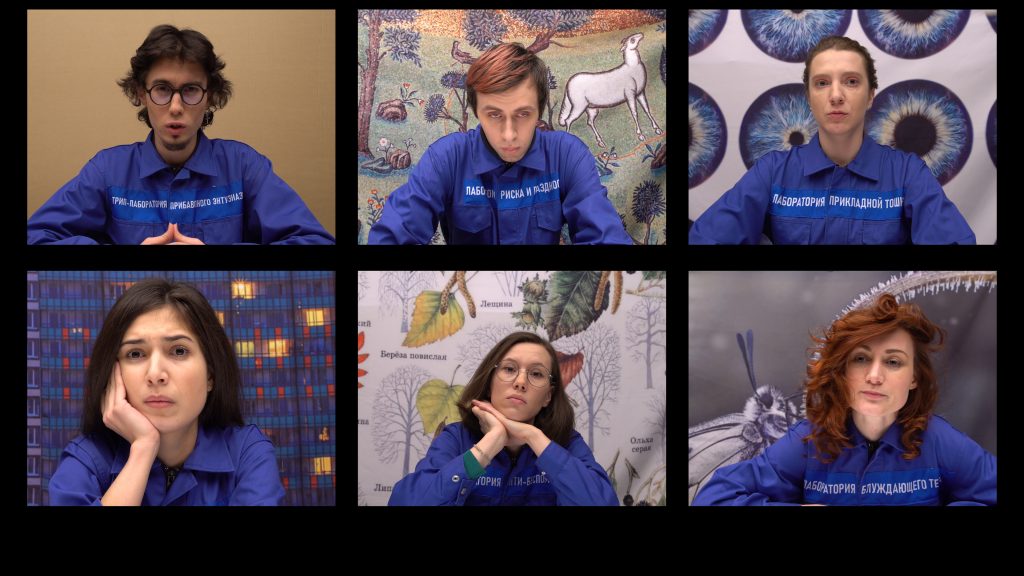
Six kinetic melodies for a useful future, 2021, still from video, 44 min., loop (directed by Tsaplya Olga Egorova), Ed. 5 + 2 AP
After almost three years, the Russian collective Chto Delat (What is to be done?) return to the The Gallery Apart with their new show New kinetic melodies: on miracles, disasters and mutations for the future. The project depicts the urge of the artists to respond to the current changes in an ever-evolving world. The tryptic Slow Learning by Zapatista is exhibited for the first time in its entirety; it is composed of three video installations shot from 2017 to 2021: The New Dead End Street. Summer School of Slow Orientation in Zapatism, (Russia, 2017); People of Flour, Water and Salt (Italy, 2019); About the footprints, what we hide in the pockets and other shadows of hope. (Greece, 2021).
The first film was shot together with a community of young Russian artists in a village near Saint Petersburg, the second film was realized with a community of migrants and refuges in the south of Italy, and the third film in collaboration with the Solidarity School in Athens. Invited for the solo show at MUAC museum in Mexico in 2017, in the wake of this journey, Chto Delat began to investigate the influence of the zapatistas ideas of social transformation outside Chiapas and to explore how these ideals might me perceived and practiced in settings outside of their original environment, and therefore how these imaginaries could mould a new reality in the contemporary world characterized by such profound and abrupt political, social and economic mutations.
Tsaplya Olga Egorova once wrote – paraphrasing Godard’s invitation “to make films politically” – that making a film zapatistically it does not mean making a film about the Zapatista movement, but instead, it means making a film that arises from the Zapatista methods themselves. It means to reinterpret and bring together fundamental principles such as equality and weakness as a means through which conquering strength. Moreover, another typical trait of the movement is dealing with the global issues with a look from below. Indeed, for the Zapatistas, the world seen from above is so small that nothing fits in other than injustice; but if seen from below, the world appears so vast and spacious to have room for justice, and everyone’s ideas and thoughts indiscriminately. Zapatistas use text and art, as a main weapon to create new poetic language that undermine the customary structures of our world through the narration of fairy tales and metaphors. This is what Chto Delat do in their trilogy that is about belonging to the land, hospitality, and the miracle.
The installation of the films is realized in the form of different wooden hand painted construction which looks like as hybrid between school table, moving wagon, or table for microfilms. It also includes a system of flag signs which are symbolizing different demands written in a special poetic language using Zapatista method of narration which combines affirmation and negation.
In the exposition will be also shown a newest video installation commissioned in March by Garage Museum, Moscow Six Kinetic Melodies for a Required Future. Shot in 2021 despite the pandemic and the arrests. It narrates the story of a utopian laboratory where the protagonists are both scientists and test subjects, aiming to develop new forms of of automatic social behaviour for surviving. The original idea for the work, conceived in the summer 2020, has undergone an unpredictable transformation due to the latest events which Chto Delat explore through the creation of an almost autobiographical film. As a result of a collective effort, mutual discussions and bodily practices, the scenario explores the adaptation to a changing social and biological life which is dramatically transformed by pandemic and current political repression in Russia.
The film is supplemented with an interactive installation: the virtual backgrounds featured in the film in the “windows” of the six protagonists turn out to be retractable curtains, behind which an “exit” into the surrounding reality is concealed, just like in Martha Rosler’s series of anti-war collages House Beautiful: Bringing the War Home. The curtains are movable and behind them one can see different viral photos of different documents depicting new frightening reality of last year events – like pollutions, the queue of ambulances, police cordoning the cities during political rallies, the interiors of police car to transport the prisoners, military drons and so on. There is a ornamental text made of artificial flowers over photographs. These ornaments are based on the numbers of a new repressive laws recently implemented in Russia. All this works presented in the show allow to create new forms of narration giving life to kinetic melodies useful for our future life.
A distanza di quasi tre anni il collettivo russo Chto Delat (What is to be done?) torna ad esporre negli spazi di The Gallery Apart con la mostra Nuove melodie cinetiche: su miracoli, disastri e mutazioni per il futuro. Il progetto illustra al meglio l’urgenza degli artisti di rispondere ai cambiamenti in atto in un mondo in continua trasformazione. Per la prima volta viene integralmente esposto il trittico Slow Learning by Zapatista, composto da tre film girati dal 2017 al 2021: New Dead End Street. Summer School of Slow Orientation in Zapatism, (Russia, 2017); Gente di farina, acqua e sale (Italia, 2019); About the footprints, what we hide in the pockets and other shadows of hope. (Grecia, 2021).
Il primo film è stato realizzato con una comunità di giovani artisti russi in un villaggio vicino a San Pietroburgo, il secondo con una comunità di migranti e rifugiati nel sud d’Italia e il terzo in collaborazione con la Scuola di Solidarietà di Atene. Invitati nel 2017 in Messico per una personale al Museo MUAC, all’indomani del loro viaggio nel paese Chto Delat ha iniziato a indagare l’influenza delle idee zapatiste di trasformazione sociale al di fuori del Chiapas e su come cioè tali ideali potrebbero essere percepite e messe in pratica in contesti lontani dal loro ambiente d’origine. In che modo, quindi, questi immaginari potrebbero plasmare una nuova realtà nel mondo contemporaneo caratterizzato da così profonde e repentine mutazioni politiche, sociali ed economiche.
Tsaplya Olga Egorova una volta scrisse, parafrasando l’invito di Godard “a fare film politicamente”, che girare un film zapatisticamente non significa fare un film sul movimento zapatista, ma piuttosto fare un film che nasce dai metodi zapatisti stessi. Significa rielaborare e combinare principi fondamentali come l’uguaglianza e la debolezza come mezzo attraverso cui conquistare la forza. Tipico della dottrina è affrontare i problemi del mondo con uno sguardo dal basso. In effetti, per gli zapatisti il mondo visto dall’alto è talmente piccolo che nulla si adatta ad esso se non l’ingiustizia, visto dal basso, invece, il mondo appare così ampio da poter contenere la giustizia, le opinioni e i pensieri di tutti indistintamente. Gli zapatisti, inoltre, utilizzano la parola attraverso l’arte e i testi scritti come arma principale grazie alla quale è possibile creare metafore che minano le strutture consuete del nostro mondo attraverso la narrazione di fiabe e metafore. È ciò che fa Chto Delat nella sua trilogia che parla, appunto, di appartenenza alla terra, ospitalità e di miracolo.
L’installazione dei film è realizzata sotto forma di diverse costruzioni in legno dipinte a mano che sembrano ibridi tra tavoli da scuola, carri mobile o tavoli per microfilm. Include anche un sistema di segnali per mezzo di bandiere che simboleggiano diverse richieste scritte in un linguaggio poetico speciale usando il metodo zapatista di narrazione che combina affermazione e negazione.
Sarà in mostra anche l’ultima video-installazione Six Kinetic Melodies for a Required Future, commissionata in marzo da Garage Museum di Mosca. Il film, girato nel corso del 2021 nonostante pandemia e arresti, narra la storia di un laboratorio utopico in cui i protagonisti sono contemporaneamente scienziati e cavie, con l’obiettivo di sviluppare nuove forme di comportamento sociale automatico per la sopravvivenza. L’idea originale dell’opera, concepita nell’estate del 2020, ha subito una trasformazione imprevedibile dovuta dagli eventi degli ultimi tempi su cui i membri di Chto Delat riflettono attraverso un film quasi autobiografico. Frutto di uno sforzo collettivo, discussioni reciproche e pratiche corporee, lo scenario esplora l’adattamento a una vita sociale e biologica che è stata drammaticamente trasformata dalla pandemia e dall’attuale repressione politica in Russia.
Il film è completato da un’installazione interattiva: gli sfondi virtuali presenti nel film nelle “finestre” dei sei protagonisti si trasformano in tende retrattili, dietro le quali si nasconde una “uscita” nella realtà circostante, proprio come nella serie di collage antibellici di Martha Rosler House Beautiful: Bringing the War Home. Le tende sono mobili e dietro di loro si possono vedere foto virali di diversi documenti che raffigurano una nuova spaventosa realtà degli eventi dello scorso anno – come gli inquinamenti, la coda di ambulanze, la polizia che circonda le città durante i raduni politici, gli interni dell’auto della polizia per trasportare i prigionieri, i militari e così via. Un testo ornamentale fatto di fiori artificiali è posto sopra le fotografie. Questi ornamenti si basano sul numero di una nuova legge repressiva recentemente introdotta in Russia. Tutti questi lavori presentati in mostra consentono di creare nuove forme di narrazione in grado di dare vita a melodie cinetiche utili e alla base della nostra vita futura.
share on